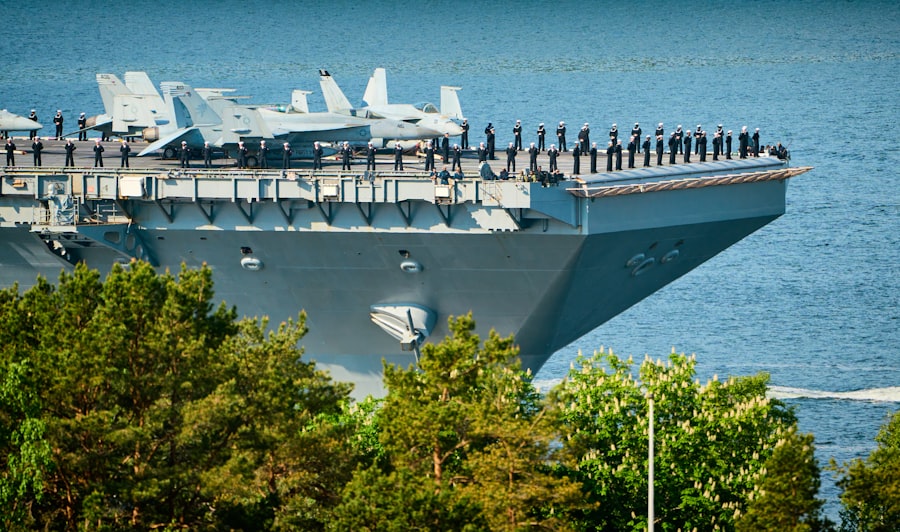The United States military stands as a formidable force on the global stage, characterized by its unparalleled capabilities and extensive reach. This dominance is not merely a product of sheer numbers or budgetary allocations; rather, it is the result of a complex interplay of advanced technology, rigorous training, strategic alliances, and a robust logistical framework. The U.S. military’s ability to project power across continents and respond to crises swiftly has established it as a leader in global security matters. As nations around the world navigate the complexities of international relations, the U.S. military’s influence remains a critical factor in shaping geopolitical dynamics. The historical context of U.S. military dominance can be traced back to its significant role in both World Wars and the Cold War, where it emerged as a superpower. The lessons learned from these conflicts have informed contemporary military strategies and operations. Today, the U.S. military continues to adapt to new challenges, including cyber warfare and asymmetric threats, ensuring that it remains at the forefront of global military capabilities. This article will explore the various elements that contribute to the U.S. military’s dominance, examining how technology, training, global presence, intelligence, logistics, alliances, special forces, military doctrine, and leadership all play integral roles in maintaining its superiority.
Key Takeaways
- The US military dominance is maintained through a combination of superior technology, extensive training, global presence, intelligence and surveillance, logistics and support, strategic alliances, special forces, military doctrine and strategy, and strong leadership and command.
- Superior technology, including advanced weaponry and equipment, plays a crucial role in maintaining US military dominance.
- Extensive training and continuous skill development are essential for the US military to stay ahead of its adversaries.
- The US military maintains its dominance worldwide through a network of bases, alliances, and strategic partnerships.
- Intelligence gathering and surveillance capabilities are critical for the US military to anticipate and counter potential threats.
Superior Technology: A Key Factor in US Military Dominance
One of the most significant contributors to U.S. military dominance is its investment in superior technology. The United States has consistently allocated substantial resources to research and development, resulting in cutting-edge weaponry and systems that outpace those of potential adversaries.
From advanced fighter jets like the F-35 Lightning II to sophisticated naval vessels such as aircraft carriers and submarines, the technological edge provides the U.S.
This technological superiority not only enhances combat effectiveness but also serves as a deterrent against potential aggressors.
Moreover, the integration of artificial intelligence (AI) and unmanned systems into military operations has revolutionized warfare.
The U.S.
military’s commitment to innovation ensures that it remains ahead of the curve in an ever-evolving battlefield landscape. As adversaries seek to develop countermeasures, the U.S. continues to push the boundaries of technology, exploring new frontiers such as cyber warfare and space-based systems that promise to redefine future conflicts.
Extensive Training: The Backbone of US Military Superiority

While technology plays a crucial role in military dominance, it is the extensive training of personnel that truly forms the backbone of U.S. military superiority. The rigorous training programs implemented across all branches of the armed forces ensure that service members are not only proficient in their respective roles but also capable of adapting to dynamic combat environments.
From basic training to specialized courses, the emphasis on discipline, teamwork, and leadership fosters a culture of excellence within the ranks. Furthermore, the U.S. military places a strong emphasis on joint operations, where different branches collaborate seamlessly during missions.
This approach requires extensive inter-service training exercises that enhance coordination and communication among forces. The ability to operate effectively as a unified entity during complex operations is a testament to the comprehensive training regimen that service members undergo. As a result, U.S.
forces are often able to execute missions with remarkable efficiency and effectiveness, further solidifying their reputation as a dominant military power.
Global Presence: How the US Military Maintains its Dominance Worldwide
| Region | Number of Military Bases | Number of Troops | Presence |
|---|---|---|---|
| Europe | 174 | 65,000 | Strong |
| Asia-Pacific | 109 | 85,000 | Significant |
| Middle East | 36 | 54,000 | High |
| Africa | 29 | 7,000 | Moderate |
| Americas | 14 | 11,000 | Limited |
The global presence of the U.S. military is another critical factor contributing to its dominance. With bases strategically located around the world, the U.S.
can project power and respond rapidly to emerging threats or humanitarian crises. This extensive network of installations not only serves as a deterrent against potential adversaries but also allows for swift deployment of forces when necessary. The ability to operate from multiple locations enhances operational flexibility and ensures that U.S.
interests are safeguarded across various regions. Additionally, this global footprint facilitates partnerships with allied nations, enabling collaborative efforts in addressing security challenges. Joint exercises and training missions conducted with partner nations strengthen relationships and enhance interoperability among forces.
The U.S. military’s commitment to maintaining a visible presence worldwide underscores its role as a stabilizing force in international affairs, reinforcing its position as a leader in global security.
The Role of Intelligence and Surveillance in US Military Dominance
Intelligence and surveillance capabilities are paramount in maintaining U.S. military dominance. The ability to gather, analyze, and disseminate information about potential threats allows for informed decision-making at all levels of command.
Advanced reconnaissance technologies, including satellites and drones equipped with high-resolution imaging systems, provide critical insights into enemy movements and intentions. This intelligence advantage enables U.S. forces to anticipate challenges and respond proactively rather than reactively.
Moreover, the integration of intelligence into operational planning enhances mission success rates significantly. By leveraging real-time data and analytics, commanders can make informed decisions that optimize resource allocation and minimize risks to personnel. The emphasis on intelligence-driven operations has become increasingly vital in modern warfare, where information superiority can often determine the outcome of conflicts.
The Importance of Logistics and Support in US Military Operations

Logistics plays an indispensable role in ensuring the effectiveness of U.S. military operations. The ability to transport troops, equipment, and supplies efficiently is crucial for sustaining combat operations over extended periods.
The U.S. military has developed sophisticated logistical networks that enable rapid deployment and resupply of forces in various theaters of operation. This logistical prowess ensures that troops are well-equipped and supported throughout their missions.
Additionally, logistical support extends beyond mere transportation; it encompasses maintenance, medical care, and supply chain management as well. The comprehensive approach to logistics ensures that service members have access to essential resources when they need them most. This capability not only enhances operational readiness but also contributes significantly to overall mission success.
The Impact of Strategic Alliances on US Military Dominance
Strategic alliances have historically played a pivotal role in bolstering U.S. military dominance on the global stage. Partnerships with allied nations enhance collective security efforts and provide access to shared resources and intelligence capabilities.
Organizations such as NATO exemplify how collaborative defense initiatives can amplify military strength through mutual support and cooperation among member states. These alliances also facilitate joint training exercises and interoperability among forces, allowing for seamless coordination during multinational operations. By fostering strong relationships with allies, the U.S.
can leverage diverse capabilities while reinforcing its own strategic objectives. In an increasingly interconnected world, these alliances serve as force multipliers that enhance U.S. military effectiveness and deter potential adversaries.
The Role of Special Forces in US Military Superiority
Special Forces units represent a unique aspect of U.S. military superiority, specializing in unconventional warfare tactics that often yield significant strategic advantages. These elite units are trained to operate in diverse environments and conduct missions ranging from counter-terrorism operations to hostage rescues and reconnaissance missions behind enemy lines.
Their ability to execute complex operations with precision makes them invaluable assets in modern warfare. Moreover, Special Forces often work closely with local forces in conflict zones, providing training and support that enhances indigenous capabilities while fostering goodwill among local populations. This approach not only contributes to mission success but also helps stabilize regions by empowering local security forces to take charge of their own defense needs.
The Influence of Military Doctrine and Strategy on US Dominance
Military doctrine and strategy play crucial roles in shaping how the U.S. approaches warfare and conflict resolution. The evolution of these doctrines reflects lessons learned from past engagements and emerging threats on the global landscape.
By adapting strategies to address contemporary challenges—such as cyber warfare or hybrid threats—the U.S. military maintains its relevance and effectiveness in an ever-changing environment. Furthermore, clear strategic objectives guide operational planning and execution across all branches of the armed forces.
This alignment ensures that resources are allocated efficiently while maximizing combat effectiveness during missions. A well-defined doctrine not only enhances internal cohesion but also communicates intent to allies and adversaries alike.
The Role of Leadership and Command in US Military Dominance
Effective leadership is paramount within the ranks of the U.S. military, influencing everything from morale to operational success rates. Leaders at all levels are tasked with making critical decisions under pressure while fostering an environment conducive to teamwork and innovation among service members.
The emphasis on leadership development ensures that individuals are prepared for increased responsibilities throughout their careers. Moreover, strong command structures facilitate clear communication channels that enhance situational awareness during operations. Leaders who prioritize adaptability and resilience empower their teams to respond effectively to unforeseen challenges on the battlefield—an essential quality in modern warfare where uncertainty is often the norm.
The Future of US Military Dominance
As global dynamics continue to evolve rapidly, the future of U.S. military dominance will depend on its ability to adapt to new challenges while maintaining its core strengths—technological superiority, extensive training programs, strategic alliances, robust logistics frameworks, intelligence capabilities, special operations expertise, sound doctrine development practices, effective leadership structures—all integral components that have historically defined its success. In an era marked by emerging threats such as cyber warfare or geopolitical tensions involving great powers like China or Russia—U.S.’s commitment towards innovation will be crucial for sustaining its position as a dominant force globally moving forward into an uncertain future where agility will be key amidst shifting paradigms within international relations landscape—ensuring peace through strength remains paramount objective guiding American defense policy for years ahead.
The United States military is renowned for its unparalleled power, a status that can be attributed to several key factors including advanced technology, substantial defense budgets, and a highly trained personnel force. A related article that delves into the intricacies of military strength can be found on MyGeoQuest, which explores various aspects of global military capabilities. For more insights, you can read the article by visiting this link. This resource provides a comprehensive overview of the elements that contribute to the formidable nature of the U.S. military, offering a deeper understanding of its global influence and operational prowess.
WATCH THIS! The Hidden Reason No One Can Invade America | A Geographical Analysis
FAQs
What factors contribute to the power of the US military?
The power of the US military is attributed to several factors, including its advanced technology, extensive training and experience of its personnel, large defense budget, and global presence through military bases and alliances.
How does the US military compare to other countries?
The US military is considered the most powerful in the world, with the largest defense budget and the most advanced weaponry and technology. It also has a global reach and is involved in various international alliances and military operations.
What role does technology play in the strength of the US military?
Technology plays a crucial role in the strength of the US military, as it has access to advanced weapons systems, surveillance and reconnaissance capabilities, cyber warfare capabilities, and cutting-edge military equipment.
How does the US military maintain its power and readiness?
The US military maintains its power and readiness through continuous training and exercises, modernization of its equipment and technology, recruitment and retention of highly skilled personnel, and strategic planning to address evolving threats and challenges.
What impact does the US military’s global presence have on its power?
The US military’s global presence, through its network of military bases and alliances, allows it to project power and influence in various regions around the world. This presence also enables the US to respond rapidly to international crises and threats.
